I have always found the story of Guglielmo Marconi’s success in transmitting the first wireless communication across the Atlantic Ocean very fascinating. You could say that Marconi’s first successful radio experiment activated a bell over a short distance. The experiment most remember Guglielmo Marconi for today was his transmission of a telegraph radio signal over thousands of miles between the United States and England. It was a first. It was also an event which many at the time thought impossible. It was an experiment which was built upon experiments already conducted by others. Whatever parts of other peoples works Marconi did or did not employ in his experiments, the act of transmitting a wireless signal over thousands of miles from one continent to another had never before been accomplished.
Thank you for reading this post, don't forget to subscribe!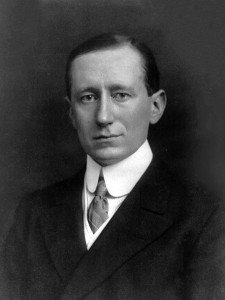 When you learn of the story you will learn how tremendous of a project this was.This was the era before transistors and semiconductors. Radio equipment in Marconi’s day was quite cumbersome.While Marconi was born and raised in Italy, much if not all of his fame was achieved while on English soil. He went to England in 1896 along with his mother. Marconi felt that the chances of advancing his wireless technology were better in England than in his native Italy. In fact, Marconi, in an effort to gain funding for his wireless projects, reached out to the English ministry of Post and Telegraphs. We do know that they did not reply to his request and it has been inferred in various historical pieces that they felt Marconi was off his rocker. They understood the telegraph system but apparently couldn’t grasp the wireless part of it. This however would change soon.
When you learn of the story you will learn how tremendous of a project this was.This was the era before transistors and semiconductors. Radio equipment in Marconi’s day was quite cumbersome.While Marconi was born and raised in Italy, much if not all of his fame was achieved while on English soil. He went to England in 1896 along with his mother. Marconi felt that the chances of advancing his wireless technology were better in England than in his native Italy. In fact, Marconi, in an effort to gain funding for his wireless projects, reached out to the English ministry of Post and Telegraphs. We do know that they did not reply to his request and it has been inferred in various historical pieces that they felt Marconi was off his rocker. They understood the telegraph system but apparently couldn’t grasp the wireless part of it. This however would change soon.
Like any inventor, the way to create public awareness and support was through actual demonstrations. Marconi, who could speak both Italian and English, set up a series of demonstrations for the British government which did begin to offer assistance. In early 1897, Marconi had transmitted Morse code close to four miles. In May of that same year he was successful in transmitting the first signals over open sea, also at a distance of close to four miles. This was between South Wales and Flat Holm Island. That was quickly followed by an experiment that sent a wireless signal about ten miles. The British were impressed.
Marconi’s “Wireless Telegraph and Signal Company” was started in 1897 after he was granted a British patent for wireless. It was renamed Marconi’s Wireless Telegraph Company in 1900. His radio experiments continued with the aim of commercialization.
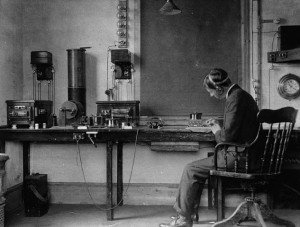
At about the year 1900, Marconi turned his attentions to finding a way to transmit wireless signals across the Atlantic Ocean. At the time, telegraphy was being sent via the undersea cables which had been laid initially in 1858 and was made permanent and much more successful in about 1868. The laying of this cable is an entire story in itself. There were many setbacks initially having to do with cable snapping off as well as rough weather conditions. The undersea cable ran from western Ireland to eastern Newfoundland. This first transatlantic cable was quite some thing. Prior to this, communication between Europe and America could only happen by ship. The transatlantic cable sped up communication to within minutes and this had a big impact, especially in regards to financial market data. Exchange rates and prices were communicated daily. The effect the transatlantic cable had on communications between North America and Europe was very similar to what the first transcontinental telegraph did for communication between Washington DC and San Francisco California.
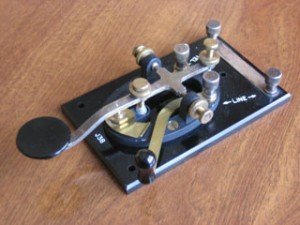 In order for Marconi to realize his vision, much had to be worked out regarding the technology. Signal strength and the antenna apparatus was key. There were many doubters. The prevailing theory from many scientists of the era was that it was impossible since it was believed that radio signals traveled the same as light, in straight lines and this would limit the distance to the curvature of the earth. As far as Marconi was concerned, he knew that wasn’t true since he had exceeded that distance in prior experiments. His theory was that the curvature of the earth could be exceeded with sufficient power. Based on his theory, one should be able to span the Atlantic Ocean if a station of proper size could be built.
In order for Marconi to realize his vision, much had to be worked out regarding the technology. Signal strength and the antenna apparatus was key. There were many doubters. The prevailing theory from many scientists of the era was that it was impossible since it was believed that radio signals traveled the same as light, in straight lines and this would limit the distance to the curvature of the earth. As far as Marconi was concerned, he knew that wasn’t true since he had exceeded that distance in prior experiments. His theory was that the curvature of the earth could be exceeded with sufficient power. Based on his theory, one should be able to span the Atlantic Ocean if a station of proper size could be built.
Based on this belief, Marconi went ahead and built a powerful new station in Cornwall England. His ideal receiving site would be Newfoundland.The station in Poldhu Cornwall would also be used for his ship to shore communications and continuing experiments. Actually, Marconi’s first customers were the marine industry since prior to radio ships could only communicate by line of sight. If you have the opportunity to read the book “Thunderstruck” by author Eric Larsen, there’s an interesting story of how Marconi’s ship to shore service helped capture a wanted murderer trying to escape England.
The stations built for both transmitting and receiving were quite large.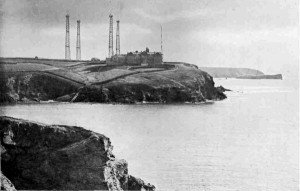 The picture at right show the antenna array at the Poldhu site in Cornwall. As you can see in the photo at right, Marconi chose a point at the very end of the land. he transmitter built here usually operated at a power of about 13 kW and a wavelength estimated at 170 meters. The four masts built had a height of 215 feet. This station continued to operate to the year 1933.
The picture at right show the antenna array at the Poldhu site in Cornwall. As you can see in the photo at right, Marconi chose a point at the very end of the land. he transmitter built here usually operated at a power of about 13 kW and a wavelength estimated at 170 meters. The four masts built had a height of 215 feet. This station continued to operate to the year 1933.
The construction on Newfoundland for a suitable receiving station was the other side to Marconi’s equation. At first he constructed the four tower array on Cape Cod. During this time his antennae in Cornwall was blown down by gale force winds. There was pressure from investors to see results so Marconi decided to build a temporary receiving station on Newfoundland. As it turned out, the cape Cod array also was blown down so Newfoundland became the site to concentrate on. Up to this point, Marconi had been successful in transmitting wireless for about 225 miles, so even though the Newfoundland station was a shorter distance than Cape Cod, it did represent a 2,100 mile challenge. The site on Newfoundland, shown in the photo below, picked for the experiments was known as Signal Hill, a point near the mouth of the harbor of St. Johns. The receiving equipment, was installed in a room in a former hospital building.
 Marconi used what was called a “coherer” as the receiving apparatus in Newfoundland. A coherer is simply a tube with two electrodes. Metal filings were placed between the electrodes and when a radio signal was received the resistance between the electrodes would be reduced and a signal were pass between the two. Developed by an inventor in France by the name of Branly, the coherer was the first receiving device used to detect a spark gap transmitter signal. It was actually a relatively simple piece of equipment. It was the device that enabled the very first radio signal receiving.
Marconi used what was called a “coherer” as the receiving apparatus in Newfoundland. A coherer is simply a tube with two electrodes. Metal filings were placed between the electrodes and when a radio signal was received the resistance between the electrodes would be reduced and a signal were pass between the two. Developed by an inventor in France by the name of Branly, the coherer was the first receiving device used to detect a spark gap transmitter signal. It was actually a relatively simple piece of equipment. It was the device that enabled the very first radio signal receiving.
The history books give a bit of confusing information as to the precise time and date Marconi was to receive the first transatlantic signal at his receiving station in Newfoundland. The popular version places it on the 12th hour of the 12th day of the 12th month in 1901. It’s been written that Thomas Edison thought Marconi may have heard static instead of signals. Some contended that in daylight it was not practical for the signals to travel such a distance. With that in mind, there are questions as to what exact frequency Marconi was using. Some say 100 Khz and others say 800 Khz. There is also the question as to how accurate frequencies could be measured in this early era. The photo below is a model of a Marconi wireless station, courtesy of the National Park Service.
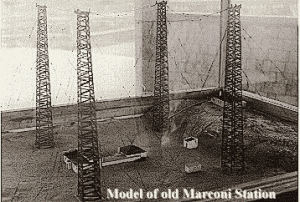 The 1901 event has been debated even to today. Most radio scientists concluded that if a signal was indeed received at Signal Hill Newfoundland in 1901, it would most likely would have had to be a short wave signal. The debate centered on exactly what type of signal was used and how the receiver and antennae were tuned. Regardless of the controversy surrounding the 1901 attempt, what is most important is that a transatlantic signal and a complete message was, without a doubt, transmitted by Guglielmo Marconi from Glace Bay Nova Scotia to Poldhu in 1902. The experiment took place in Nova Scotia in 1902 rather than in Newfoundland due to the Anglo-American Cable Company ordering the Signal Hill site to be closed down. This just demonstrates the commercial competitiveness of the whole wireless endeavor at that time.
The 1901 event has been debated even to today. Most radio scientists concluded that if a signal was indeed received at Signal Hill Newfoundland in 1901, it would most likely would have had to be a short wave signal. The debate centered on exactly what type of signal was used and how the receiver and antennae were tuned. Regardless of the controversy surrounding the 1901 attempt, what is most important is that a transatlantic signal and a complete message was, without a doubt, transmitted by Guglielmo Marconi from Glace Bay Nova Scotia to Poldhu in 1902. The experiment took place in Nova Scotia in 1902 rather than in Newfoundland due to the Anglo-American Cable Company ordering the Signal Hill site to be closed down. This just demonstrates the commercial competitiveness of the whole wireless endeavor at that time.
Today, it is possible to travel to these same historic sites to learn more about Guglielmo Marconi and his amazing transatlantic radio experiments. These are excellent trips into history.
The Marconi National Historic Site of Canada, in Glace Bay, Nova Scotia, is the site of Guglielmo Marconi’s first transatlantic wireless station and the first wireless message sent from North America to Europe. The site features the remnants of Marconi’s transmission towers, along with a museum chronicling Marconi’s achievements.
In 2001, the Marconi Centre was opened in Poldhu Cornwall. The Marconi Centre features a video presentation showing the significance of Poldhu and Marconi’s work. There are also much additional information on wall panels. The Centre is owned by the National Trust and run by the Poldhu Amateur Radio Club. Admission is free.

